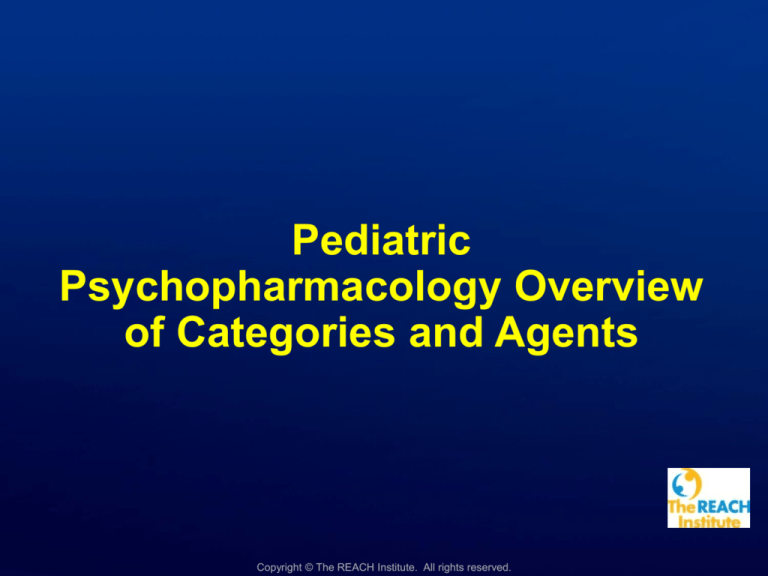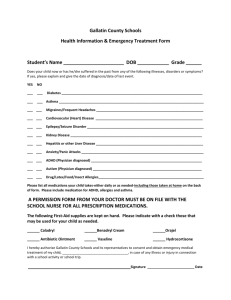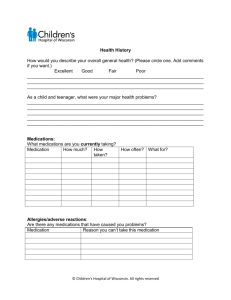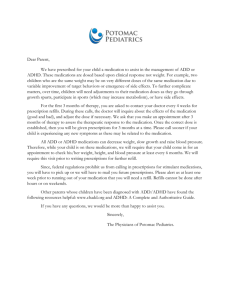
Pediatric
Psychopharmacology Overview
of Categories and Agents
Copyright © The REACH Institute. All rights reserved.
Learning Objectives
• To describe general guidelines for the use
of psychoactive medications in the
pediatric population
• To discuss recommendations for
establishing an effective working alliance
and “partnering” with families
• To review the basic categories and
indications of pediatric
psychopharmacology
Copyright © The REACH Institute. All rights reserved.
Urgent Appointment—Alex
• Friday, 4:30 pm appointment
• Alex is a 14 y/o boy who was discharged from a
psychiatric hospital 4 weeks ago, now running
out of medications (family missed follow-up
appointment with psychiatrist)
• Alex’s mother, Janet, reports that Alex has
“mood swings” and was discharged after two
months with a diagnosis of Bipolar Depression,
ADHD, and Aggression
• When you ask about Alex’s medications,
Alex’s mother gives you this zip-lock bag
Copyright © The REACH Institute. All rights reserved.
Urgent Appointment—Alex
• Methylphenidate (Concerta) 18 mg
daily
• Lorazepam (Ativan) 1mg TID
• Risperidone (Risperdal) 2 mg BID
• Valproic Acid (Depakote) 750 mg BID
(no level available)
• Escitalopram (Cipralex) 20 mg daily
Copyright © The REACH Institute. All rights reserved.
Activity: Medication Reconciliation
TABLES – As a group: Identify classes, indications,
and dose levels for each bottle of medication.
SCRIBES: On your flipchart, create a chart with 4
columns:
– Name of agent
– Class (or type) of drug
– Indication: What is it used for?
– Dose: Is the dose low, average, or too high?
Complete the chart for each medication in Alex’s bag.
Copyright © The REACH Institute. All rights reserved.
The REACH First Principles
1: Developmental / Contextual Assessment
•Assess children & adolescents’ networks: family, friends,
neighborhood, schools, etc.
• Do a thorough diagnostic & bio-psycho-social evaluation
• Medications cannot replace needs for family support, safety,
parenting skills, friends, meaningful hobbies, self-esteem, etc.
•Diagnostic systems (DSM & ICD) have limitations in
assessing children and their contexts
– Diagnoses may unfold over time, and initial symptoms and
diagnoses may differ from later adult diagnoses
•Psychiatric medications are generally just one part of a
meaningful, effective treatment plan
Adapted from Connor and Meltzer: Pediatric Psychopharmacology
Copyright © The REACH Institute. All rights reserved.
The REACH First Principles
2: Team Formation, Communication, and Decision-Making
• Fully involve family & child in decision-making re:
medications use (shared decision making)
– Inquire about concerns, continue to address their concerns
• Medication approaches must recognize chronicity of
childhood neuropsychiatric disorders, by providing:
– Parental and youth support, empowerment, self-management,
and patient activation to promote recovery and hope
– Sustained therapeutic alliance and problem-solving
• Treat primary diagnosis (or the most urgent or impairing
problem) with indicated medication first
• Use systematic rating scale to measure agreed-upon
target symptoms at baseline and throughout treatment
Copyright © The REACH Institute. All rights reserved.
The REACH First Principles
3: Do No Harm
• Children & youth are different than adults e.g.
developmental differences for efficacy & side effects
– E.g. SSRIs, TCAs, stimulants
• Children may require proportionately higher doses: faster
metabolism, kidney clearance, and liver-to-body-size ratio
• Use medications at appropriate RCT-documented dose
and duration before changing or augmenting
• Start low, go slow, taper slow (exception: stimulants can
be discontinued more quickly)
• Use systematic rating method to measure side effects
Adapted from Connor and Meltzer: Pediatric Psychopharmacology
Copyright © The REACH Institute. All rights reserved.
The REACH First Principles
4: Evidence-based Prescribing Practices
• Whenever possible, use medications supported by
double-blind RCTs for this age group and diagnosis
•Minimize use of multiple medications
•When changing meds:
– Make only one med change at a time; monitor results
– Always consider environmental strategies as alternative or complement
– “Don’t change horses mid-stream”
•Evaluate iatrogenic effects of multiple medications
– When unclear, consider tapering or discontinuing most worrisome
medication or the one with the least amount of RCT evidence
Copyright © The REACH Institute. All rights reserved.
RESOURCE SLIDE:
Effective Working Alliance
• Ensure case formulation precedes
prescription
• Emote a sense of understanding in
communications with patients and
families
• Involve the patient/family in the
decision-making process
• Assess the understanding of the
mental illness and meaning of
medication for the patient and family
• Nurture all professional relationships
necessary to sustain child’s health
• Visit consumer websites often and
help families connect to support
groups
• Identify references and books to help
patients
• When discussing pharmacotherapy,
pause and listen to family’s response
to word “medication”
• Provide a small number of choice of
medications whenever possible so that
past associations with a particular med
do not derail treatment
• Respect the family’s right to informed
consent and need to know about side
effects, without burdening them with so
much info they feel overwhelmed
• Practice the 3 C’s of good
pharmacotherapy:
– Collaboration (therapists, other providers,
families)
– Conscientiousness (of standard of practice
and socio-cultural needs)
– Communication (return phone calls and emails promptly, be available, document so
others follow pharmacotherapy reasoning
• Remember all actions have potential
meaning for patients and families, from
pens, to language, to the way the
prescriber provides realistic hope for the
future
From Joshi, Teamwork: The Therapeutic Alliance in Pediatric Pharmacotherapy, Child and Adolescent Psych Clinics of NA, Jan 2006
Copyright © The REACH Institute. All rights reserved.
See A 1.0
Studies and Acronyms to Know
MTA: Multimodal Treatment Study of Children with
Attention Deficit Hyperactivity Disorder
PATS: The Preschool ADHD Treatment Study
TADS: Treatment for Adolescents with Depression
Study
CAMS: The Child/Adolescent Multimodal Study
Copyright © The REACH Institute. All rights reserved.
Studies Referenced
MTA: Multimodal Treatment Study of Children with
Attention Deficit Hyperactivity Disorder - Examined
for the first time the safety and relative
effectiveness of these two treatments—alone and
in combination for a time period of up to 14
months, and compared these treatments to routine
community care. Combination treatment and
medication management alone were both
significantly superior to intensive behavioral
treatment alone and to routine community care in
reducing ADHD symptoms. The study also showed
that these benefits last for as long as 14 months.
Copyright © The REACH Institute. All rights reserved.
See WBk A 1.6
Studies Referenced
PATS: The Preschool ADHD Treatment Study
provides us with the best information to date
about treating very young children diagnosed
with ADHD," said NIMH Director Thomas R.
Insel, MD. "The results show that preschoolers
may benefit from low doses of medication
when it is closely monitored, but the positive
effects are less evident and side-effects are
somewhat greater than previous reports in
older children."
See WBk A 1.7
Copyright © The REACH Institute. All rights reserved.
Studies Referenced
TADS: Treatment for Adolescents with
Depression Study - A multi-site clinical
research study examining the short- and longterm effectiveness of an antidepressant
medication and psychotherapy alone and in
combination for treating depression in
adolescents ages 12 to 17.
Copyright © The REACH Institute. All rights reserved.
See WBk A 1.8
Studies Referenced
CAMS: The Child/Adolescent Multimodal Study
randomly assigned 488 children and adolescents
ages 7 to 17 years to one of four treatment options
for a 12 week period. 81 percent of children and
adolescents receiving combination treatment
improved. Sixty percent of them receiving CBT only
improved and 55 percent receiving antidepressant
medication only improved. Twenty four percent of
those receiving only placebo improved.
Copyright © The REACH Institute. All rights reserved.
See WBk A 1.9
What medications are used for
ADHD?
Copyright
Copyright
© 2014
© TheThe
REACH
REACH
Institute.
Institute.
All All
rights
rights
reserved.
reserved.
FDA-Approved Medications for
ADHD
• Stimulants
• Methylphenidate – e.g., Ritalin (LA), Concerta, Focalin
(XR), Daytrana, Methylin, Metadate (CD), Quillivant XR
• Amphetamine – e.g., Dexedrine, Adderall (XR), Vyvanse
• Non-stimulants
• Atomoxetine (Strattera)
• Guanfacine XR (Intuniv)
• Clonidine XR (Kapvay)
Copyright © The REACH Institute. All rights reserved.
Stimulant Medications: Efficacy
• Safety and efficacy studies in over 200 controlled
studies of ADHD in school-age children
• One of the most robust treatments in psychiatry
• Effective in approximately 70% of children with
ADHD—generally equal efficacy across stimulants
• An additional 20% will respond to the next one
attempted
• If the 1st and 2nd choices fail, check for wrong
diagnosis and/or previously unrecognized
comorbidity
Copyright © The REACH Institute. All rights reserved.
Stimulant Medications: Mechanisms
• MPH exerts much of its
effect through dopamine
uptake blockade by
inhibition of dopamine
transporter (DAT) of
central adrenergic neurons
Nerve
Impulse
Dopamine
Norepinephrine
TH
MPH
blocks
DAT Transporter
• By contrast,
amphetamines not only
block DAT, but also
increase catecholamine
release as a primary
mechanism
Synapse
Receptors
• Both increase spontaneously released dopamine that
enhances response to environmental stimuli
Copyright © The REACH Institute. All rights reserved.
Non-Stimulant Medication
Efficacy
Atomoxetine (Strattera) is approved for the
treatment of children, adolescents, and adults with
ADHD
– Head-to-head comparison with OROS-methylphenidate
(Concerta): OROS-MPH more effective than
atomoxetine (Newcorn et al, Am J Psychiatry, 2008),
e.g. Effect sizes 0.8-1.0 vs. 0.4-0.5 in stimulant naive
Guanfacine XR (Intuniv) and Clonidine XR
(Kapvay) approved for the treatment of children &
adolescents 6-17
Copyright © The REACH Institute. All rights reserved.
Non-Stimulant Medication
Mechanism of Action
Atomoxetine (Strattera) blocks
reuptake at the noradrenergic neurons
(selective noradrergic reuptake
inhibition – SNRI)
Guanfacine XR (Intuniv) and Clonidine
XR (Kapvay) - alpha-2A adrenergic
receptor agonists
Copyright © The REACH Institute. All rights reserved.
Cardiovascular Monitoring and
Stimulants
A thorough patient and family history and
physical examination should be performed.
Treatment without obtaining routine ECGs or routine
subspecialty cardiology evaluations is appropriate
for most children.
Acquiring an ECG is not mandatory, but rather is left
to the physician's discretion.
PEDIATRICS Volume 122, Number 2, August 2008
*More to come in ADHD Unit
Copyright © The REACH Institute. All rights reserved.
What about the
antidepressant medications?
Copyright
Copyright
© 2014
© TheThe
REACH
REACH
Institute.
Institute.
All All
rights
rights
reserved.
reserved.
Treatments for Depression
• Pharmacotherapy
• Fluoxetine (Prozac)--FDA approved for pediatric
patients 8-18 years of age
• Escitalopram (Lexapro)--FDA approved for adolescents
12-17 years of age
• Psychotherapy: Cognitive Behavioral Therapy (CBT)
• Interpersonal psychotherapy- some evidence supporting
role in pediatric depression
• ECT
• Light Therapy
• TMS (transcranial magnetic stimulation) – preliminary
study
Copyright © The REACH Institute. All rights reserved.
Antidepressants—Mechanism
• SSRIs selectively block the reuptake of
5-HT (first-line pharmacotherapy)
• TCAs block the reuptake of 5-HT
and/or norepinephrine
• MAOIs block monoamine oxidase
(MAO), thereby blocking metabolism
and increasing neurotransmitter
availability in the synapse
Copyright © The REACH Institute. All rights reserved.
Response Rates in RCT’s of Antidepressants (for
depression) based on CGI (Clinical Global Impression)
MEDICATION
Drug
Placebo
P value
Fluoxetine (Prozac) (March ’04)*
56%
33%
0.02
Fluoxetine (Prozac) (Emslie ’97)
52%
37%
0.03
Fluoxetine (Prozac) (Emslie ’02)
61%
35%
0.001
Paroxetine (Paxil) (Keller ’01)**
66%
48%
0.02
Paroxetine (Paxil) (Unpublished)
69%
57%
NS
Paroxetine (Paxil) (Unpublished)
65%
46%
0.005
Citalopram (Celexa) (Wagner ’04)
47%
45%
NS
Sertraline (Zoloft) (Wagner ’03)
63%
53%
0.05
Escitalopram (Cipralex) (Emslie ’09)
64%
53%
0.03
*Fluoxetine alone compared to placebo
**Paroxetine compared to placebo
Copyright © The REACH Institute. All rights reserved.
The FDA Boxed Warning
“the Black Box”
• Suicidality
– incr. risk of suicidality in children, adolescents and young adults w/ major
depressive or other psychiatric disorders esp. during 1st months of tx w/
antidepressants vs. placebo; weigh risk vs. benefit; in short-term studies of
antidepressants vs. placebo, suicidality risk not increased in pts >24 y/o,
and risk decreased in pts >65 y/o; observe all pts for clinical worsening,
suicidality, or unusual behavior changes
• Applies to all medications with FDA indication for
depression
– Antidepressants (SSRIs, SNRIs, TCAs, MAOIs, others)
– Others with FDA indication
For example, quetiapine (Seroquel) has the warning due to indication in adults
for bipolar depression and aripiprazole (Abilify) has the warning due to indication
in adults for adjunct treatment of depression
• To be discussed further in upcoming sessions
Copyright © The REACH Institute. All rights reserved.
What about
mood stabilizers and
antipsychotics for
children and adolescents?
Copyright
Copyright
© 2014
© TheThe
REACH
REACH
Institute.
Institute.
All All
rights
rights
reserved.
reserved.
Mood Stabilizers
• Lithium—only traditional mood stabilizer with
FDA indication for treatment of Bipolar Disorder
in children 12 and older
• Valproic Acid—FDA indication for seizure
disorder in children (but not for Bipolar Disorder)
• Carbamazepine (Tegretol)—FDA indication for
seizure disorder (but not for Bipolar Disorder)
• Oxcarbazepine (Trileptal)—evidence stronger for
younger children (no FDA indication for Bipolar
Disorder)
Copyright © The REACH Institute. All rights reserved.
Atypical Antipsychotics
• Risperidone (Risperdal)
– FDA indication for bipolar disorder, Acute Mania for children 10-17
– Also has indication for schizophrenia for children ages 13-17 and the
irritability symptoms of autistic disorder in children ages 5-16
• Aripiprazole (Abilify)
– FDA indication for bipolar disorder, Acute Mania for children 10-17
– Also has indication for schizophrenia for children ages 13-17 and the
irritability symptoms of autistic disorder in children ages 6-17
• Quetiapine (Seroquel)
– FDA indication for bipolar disorder, Acute Mania for children 10-17
– Also has indication for schizophrenia for children ages 13-17
• Olanzapine (Zyprexa)
– FDA indication for bipolar disorder, manic or mixed episodes , ages 13-17
– Also has indication for schizophrenia for children ages 13-17
•
Evidence also for aggression but must weigh side effects and consider
general principles (thorough diagnostic eval, treat primary disorder, etc)
Copyright © The REACH Institute. All rights reserved.
Safety and Tolerability of
Atypical Antipsychotics
Antichol- Elevated
inergic prolactin
EPS
Orthostasis
QTc
Weight
Increase Sedation Gain
++++
0/+
0/+
+++
+
++++
++++
Risperidone
+
++++
++
++
+
+
+++
Olanzapine
++
++
+
++
+
+++
++++
Quetiapine
+
0/+
0/+
++
+
++
++
Ziprasidone
+
+
+
+
++
+
0/+
Aripiprazole*
0/+
0/+
+
+
0
+
0/+
Clozapine
Adapted from: Pappadopulos EA et al. Schizophr Bull. 2002;28:111-121. Marder et al, 2003; Potkin et al, 2003.
SEE T-MAY Reference Guide
Copyright © The REACH Institute. All rights reserved.
Monitoring Side Effects
• Antipsychotic Use in Children and
Adolescents: Minimizing Adverse Effects to
Maximize Outcomes.
– Correll, C. Journal of the American Academy
of Child & Adolescent Psychiatry. 47(1):9-20,
January 2008
• BMI Percentile Calculator
– http://apps.nccd.cdc.gov/dnpabmi/Calculator.a
spx, T-MAY Tool Kit
Copyright © The REACH Institute. All rights reserved.
Summary
• Meds in Pediatric Psychopharmacology
have extensive data in support of safety
and efficacy, given the correct diagnosis
• The most common disorders (ADHD,
depression, anxiety, and disruptive
behavior disorders) can be effectively
treated & monitored in primary care – you
can do it!
• Many children will benefit by your learning
the safe & appropriate use of these agents
Copyright © The REACH Institute. All rights reserved.
REMINDER:
Please fill out Unit A
evaluation
Copyright © The REACH Institute. All rights reserved.
RESOURCE SLIDE:
Annotated Bibliography
• Pediatric Psychopharmacology: Fast Facts.
– Book by Daniel Connor and Bruce Meltzer reviewing psychiatric
medications for children and adolescents by medication and by disorder.
Information is clearly and effectively organized and communicated. Latest
version: 2006
• Straight Talk About Psychiatric Medications for Kids
– Book and guide for parents (and prescribers) by Timothy Wilens about
medications for kids. Addresses questions such as: When is medication
the right choice? What are the alternatives? Are medications safe for my
growing child?
• The Prescriber’s Guide
– Reference book by Stephen Stahl providing easy-to-understand graphics for
all psychiatric medications. Not focused on children and adolescents.
Copyright © The REACH Institute. All rights reserved.
See WBk A 1.4
RESOURCE SLIDE:
Additional Resources for
Primary Care Clinicians
• www.pdr.net
– This web site is free for US-based prescribers. It offers
access to the PDR entries for medications which are updated
on a regular basis
• www.epocrates.com
– Free on-line version allows access to latest data on
medications, including dosing for FDA indications.
Palm/Pocket version also available
• www.parentsmedguide.org
– This web site is a collaborative effort by the American
Academy of child and Adolescent Psychiatry and the
American Psychiatric Association. Practical information and
advice for parents, patients and clinicians is posted regarding
ADHD, pediatric depression and bipolar disorder.
See WBk A 1.5
Copyright © The REACH Institute. All rights reserved.









